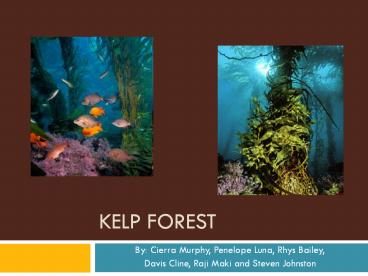Kelp forest - PowerPoint PPT Presentation
1 / 18
Title:
Kelp forest
Description:
KELP FOREST By: Cierra Murphy, Penelope Luna, Rhys Bailey, Davis Cline, Raji Maki and Steven Johnston Physical Description Full of kelp and different animals Cold ... – PowerPoint PPT presentation
Number of Views:839
Avg rating:3.0/5.0
Title: Kelp forest
1
Kelp forest
- By Cierra Murphy, Penelope Luna, Rhys Bailey,
- Davis Cline, Raji Maki and Steven Johnston
2
Physical Description
- Full of kelp and different animals
- Cold because kelp forests live in cold, nutrient
rich waters - Towards the surface there is a lot of light
- Towards the bottom it is dark from the shadows of
the kelp
3
Biological Description
- A lot of kelp that grows very high, algae and
other plant life - A nursery for animal life
4
Where they are found in the Northwest
- Some found off the coast of Oregon
- Most found off the coast of California and off
Mexico
5
Value of Kelp Forests
- Hundreds of animals depend on kelp forest because
they live and breed there - Kelp extract is found in everyday items like
toothpaste, ice cream, and salad dressing
6
Kelp Rock Fish
- Scientific name is Sebastes Atrovirens
- Adaptations are the spines on its back for
protection against enemies and its color to blend
in with the kelp - They feed on small crabs, shrimps, amphipods,
isopods, squids, and some fishes, including
juvenile rockfishes. - Humans hunt and eat them
7
Giant Kelp Fish
- Scientific name is Heterostichus rostratus
- Adaptations are they change color to blend in,
the shape of their bodies help them blend into
kelp, and they males guard the eggs - They eat crustaceans, small fish and mollusks
- Humans, sharks and turtles eat them
8
California Barracuda
- Scientific name is sphyraena argentea
- Adaptations are they have teeth to catch prey,
they pump jaws to move faster, move slow towards
prey so they dont scare them away then snap to
catch them - They eat small fish
- Humans eat them
9
Cabezon
- Scientific name is Scorpaenichthys marmoratus
- Adaptations are Their eggs are poisonous to
humans, and many other mammals and birds. Their
young drift out to sea, and then grow into small,
silvery fish that often hide under mats of
drifting kelp. As they grow older, the fish
settle into tide pools, and then move to reefs
and kelp forests. - Diet crustaceans, fishes, mollusks
10
Bat Ray
- Scientific name Myliobatis Californica
- Their adaptations are they have a venomous tail,
they burry themselves in sand to catch prey, and
They are able to locate prey by detecting the
electrical fields produced by muscles and nerves
of animals - They eat shrimp, crabs, and bottom dwelling
invertebrates - Humans eat them
11
Brown Turban snail
- Scientific name Tegula brunnea
- Adaptation The turban snail reproduces by
releasing their eggs and sperm into the water
where they collide and fertilization occurs - What they feed on Their diet consist of several
different forms of algae including diatoms and
Bryozoans(moss animals)
12
Sunflower Star
- Scientific name is Pycnopodia Helianthoides
- Adaptations are it has 24 arms, and a total of
about 15,000 tube feet. It can move at up to 40
inches per minute (0.038mph). - It eats small invertebrates such as crabs,
snails, sea cucumbers, other small shell animals,
and other sea stars.
13
Red Octopus
- Scientific name Octopus rubescens
- Adaptations are they can change color, they have
an ink sacks for protection, and are small to fit
in cracks between rocks - They eat fish
- Humans and squid eat them
14
California Moray Eel
- Scientific name is Gymnothorax Mordax
- Adaptations are their large teeth, their snake
like bodies allow them to go between rocks, and
it does not use gills to breathe - They eat crustaceans, octopuses and small fish
- Humans eat them
15
Lesser Scaup
- Scientific name is Aythya affinis
- Their adaptations are they are buoyant so they
can float on water, they dive shallow by
increasing blood volume and then blood oxygen
stores while decreasing respiratory volume, body
allows them to dive without floating back to
surface - They eat insect larvae, crustaceans, and mollusks
- Snapping turtles and larger birds eat them
16
Sea Otter
- Scientific name is Enhydra Lutris
- Adaptations they tie themselves up in the kelp
so they dont float away when they are sleeping
and they are excellent swimmers - They eat clams, snails, abalone, crabs, starfish,
mussels, scallops, squid, chitons, small
octopuses, sea urchins, prawns, sea cucumbers,
limpets, marine worms, several types of fish, and
a variety of other things - Sharks, stellar sea lions, and killer whales eat
otters
17
Zonation
- Canopy zone- This zone is made up primarily of
kelp. Specifically Macrocystis pyrifera. This
kelp dominates the zone and prevents other
species from growing here. - Midwater zone(stipe zone)- This zone is the
largest of the three. It is home to the most of
the species of fish and kelp present in the kelp
forest. - Benthic zone- This zone is on the very bottom of
the kelp forest. Here the kelp has no way to
float and lay on the floor. Invertebrates
overrun this zone and algae is growing on almost
every surface.
18
References
- http//life.bio.sunysb.edu/marinebio/kelpforest.ht
ml, Kelp Forests - http//sanctuaries.noaa.gov/about/ecosystems/kelpd
esc.html, Ecosystems Kelp Forests Office of
Natural Marine Sanctuaries, Apr. 26, 2007 - http//www.calstatela.edu/faculty/eviau/edit557/oc
eans/norma/oklpfst.htm, The Kelp Forest 1994 - http//jellieszone.com/kelpforest.htm, Forests of
Kelp Jellies Zone - http//www.sanctuarysimon.org/monterey/sections/ke
lpForests/overview.php?seckf, Monterey Bay
Sanctuaries Kelp Forest SIMoN Organization































